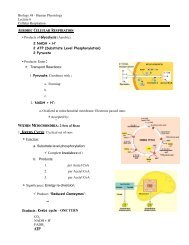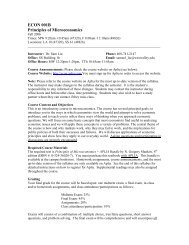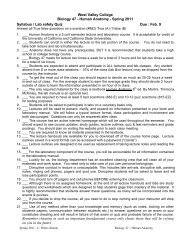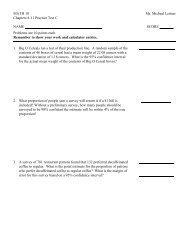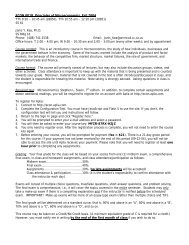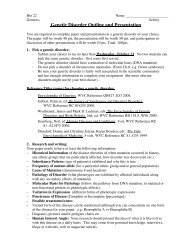Part A
Part A
Part A
Create successful ePaper yourself
Turn your PDF publications into a flip-book with our unique Google optimized e-Paper software.
Study Guide- Microbiology Exam 1 Fall 2005<br />
Tips for success-<br />
1. HANDWRITE out your study guide. Some (very few) students do fine with typing, but<br />
most do much better when they handwrite their study guide.<br />
2. Don’t split up the parts among people in a group. The benefits of doing the study guide<br />
are gained from actually writing out the answers yourself. It’s great to work in groups and<br />
discuss the answers with others, but be sure you do your own writing. Besides if I see<br />
exact copies of study guides, no one in the group will get the extra credit for it.<br />
3. Draw yourself diagrams and pictures whenever you can to illustrate processes. You<br />
can redraw the pictures for yourself on your exam and use them as models to answer<br />
questions. If you can, create a little “movie” in your head of cellular processes.<br />
4. Focus on learning processes rather than just definitions whenever applicable. For<br />
example, for the vocabulary term below-“photosynthesis” you should not stop at defining<br />
it, but should be sure that you understand what kinds of organism do it, what kind of<br />
environmental conditions are required, how the process works, what are the reactants and<br />
products, etc.<br />
5. Get a good night’s sleep and eat a good breakfast before the exam. An extra hour of<br />
sleep will be more valuable than an extra hour of studying if you are exhausted. If you<br />
find yourself in this predicament often, then you need to start studying much earlier for<br />
the exam.<br />
<strong>Part</strong> 1- Introduction<br />
Vocabulary:<br />
Microorganism<br />
Taxonomy<br />
Binomial Nomenclature<br />
Prokaryote<br />
Eukaryote<br />
Archaea<br />
Eubacteria<br />
“animacules”<br />
Spontaneous generation<br />
Pathogen<br />
Miasma<br />
Humors<br />
Puerperal fever<br />
Germ Theory<br />
Cholera<br />
Anthrax<br />
Nosocomial
Study Guide- Microbiology Exam 1 Fall 2005<br />
Immunology<br />
Serology<br />
Etiology<br />
Epidemiology<br />
Chemotherapy<br />
Biochemistry<br />
Microbiology<br />
Parasitology<br />
Mycology<br />
Virology<br />
1. Describe the characteristics of each of the following microbes: bacteria, protozoa,<br />
helminthes, cyanobacteria, algae, virus and fungi esp. yeast.<br />
2. Describe the contributions of Linneaus to the field of Taxonomy. Describe the<br />
conventions used when using binomial nomenclature.<br />
3. Describe the contributions of Hooke and Leeuwenhoek to the field of microbiology.<br />
4. Who is Bergey? What is the importance of the Bergey Manual?<br />
5. Describe the five-kingdom system of classification. Compare it to the three-domain<br />
system. Which is more current? Why? How do they overlap? Draw a diagram.<br />
6. Describe the contributions to the field of microbiology of each of the following<br />
individuals: Pasteur, Tyndall, Semmelweis, Snow, Fracastoro, Lister, Koch.<br />
<strong>Part</strong> 2- Biochemistry<br />
Vocabulary:<br />
Elements<br />
CHNOPS<br />
Electrons<br />
Protons<br />
Neutrons<br />
Atomic Number<br />
Atomic Mass<br />
Ions<br />
Isotopes<br />
Bonds: Covalent, Ionic, Hydrogen<br />
Macromolecules: Lipids, Carbs, Proteins, Nucleic Acids<br />
Polymers<br />
Monomers<br />
Enzymes<br />
Hormones<br />
Polar<br />
Non-polar<br />
Hydrophobic<br />
Hydrophilic<br />
Amphipathic
Study Guide- Microbiology Exam 1 Fall 2005<br />
1. Describe the differences and similarities between covalent, ionic and hydrogen bonds.<br />
Which general types of elements/molecules engage in each type?<br />
2. Describe how water molecules are held together. How are adjacent water molecules<br />
held to each other at room temp, frozen and as steam?<br />
3. How is water both an acid and a base? Describe the influence of H+ and OHconcentration<br />
on acidity and alkalinity. List some common acids and bases. How do you<br />
recognize them in terms of nomenclature?<br />
4. Describe the characteristics of each of the four biological macromolecules. List the<br />
monomers for each. Where in biological systems is each one found (i.e. what are some<br />
uses/functions of each)?<br />
5. Describe the four levels of protein structure. What are some biological functions of<br />
proteins? How is protein shape related to function?<br />
6. What are enzymes? How do they function in cells?<br />
7. What is phosphorylation? How is it related to enzyme function?<br />
<strong>Part</strong> 3- Eukaryotic Cell Structures<br />
Vocabulary:<br />
Micrometer<br />
Nanometer<br />
Flagella<br />
Cilia<br />
Microtubules<br />
Microfilaments<br />
Pseudopodia<br />
Cell walls<br />
Chitin<br />
Cellulose<br />
Plasma/cell membrane<br />
Phospholipids<br />
Sterols<br />
Fluid mosaic<br />
Endocytosis<br />
Exocytosis<br />
Osmosis<br />
Diffusion<br />
Facilitated diffusion<br />
Active transport<br />
Chromatin
Study Guide- Microbiology Exam 1 Fall 2005<br />
Chromosomes<br />
Endosymbiont Theory<br />
Mitosis<br />
Meiosis<br />
Binary Fission<br />
Budding<br />
1. Describe the functions of each of the following organelles and structures: Nucleus,<br />
endoplasmic reticulum, mitochondria, vacuoles, peroxisomes, lysosomes, golgi<br />
apparatus, nucleolus, cytoplasm, cytoskeleton, ribosomes, chloroplasts.<br />
2. Describe how eukaryotic cells are different from prokaryotic cells. Which kind of cells<br />
is more abundant in nature? Which kind is more ancient? Which kind is found in each<br />
kingdom? Domain?<br />
3. What are some major functions of the plasma/cell membrane? How is this different<br />
from a cell wall? What kinds of cells have cell walls?<br />
4. How do substances cross cell membranes? Generally speaking, what types of<br />
substances use each way? List and describe at least five ways. Draw diagrams of each as<br />
needed. Which require energy and which are spontaneous? When energy is required, how<br />
is it obtained?



